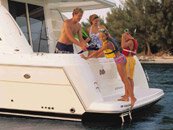Beginner Sailing
The keel is basically a flat blade sticking down into the water from a sailboat’s bottom. It has two functions: it prevents the boat from being blown sideways by the wind, and it holds the ballast that keeps the boat right-side up. That’s all you really need to know about the keel to enjoy sailing—OK, you have to know how deep it is so you don’t run aground—but in fact the keel is a pretty interesting structure.
Keels come in many styles. Traditional boats have graceful keels built into the shape of the hull; the ballast is either bolted to the bottom of the keel or placed inside it. The keel is built of whatever the boat is built of—usually fiberglass, aluminum or wood—and the ballast is lead. This is a sturdy, time-proven design, especially good for a cruising boat, which might run aground on an uncharted reef or require hauling out in a remote part of the world.
- But boats with “built-down” keels as described above tend to be slow-ish, so most modern sailboats use “fin” keels. These high-performance, low-drag appendages are usually cast in lead and bolted to the flattish bottom of the hull; some fiberglass boats have a stub molded into the bottom and the ballast is bolted to that. Most fin keels look like the wings of fighter jets, while others—those on America’s Cup yachts, for example—resemble abstract sculptures, and you wonder what holds them on.
- Fin keels not only provide ballast, but are more efficient than built-down keels at preventing “leeway”—sideways movement of the boat caused by the wind on the sails. Leeway is a problem especially when the boat’s sailing “to windward,” or into the wind, and sailboats almost always make a little bit of leeway—maybe just a few degrees. But that’s enough to create an “angle of attack” between the water flow and the fin, which in turn creates a pressure differential between the two sides of the fin. This is just like the lift created by wind moving across an airplane wing, or blowing over a sail, but it’s happening under the boat. The keel is drawn toward the lower-pressure side, which, fortunately, is the windward side. Therefore the fin keel tries to pull itself, and the boat, into the wind, thereby negating almost all of the wind-induced leeway, leaving just enough to continue to create lift around the keel.
Most new sailors think the keel’s there just for ballast, but now you know better. It’s really a wing, flying under your boat.
See Also:


